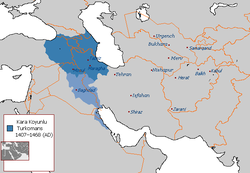黑羊王朝
黑羊王朝 | |||||||||||
|---|---|---|---|---|---|---|---|---|---|---|---|
| 1374年—1468年 | |||||||||||
 黑羊王朝,1407年—1468年 | |||||||||||
| 地位 | 邦联 | ||||||||||
| 首都 | 大不里士 | ||||||||||
| 历史 | |||||||||||
• 建立 | 1374年 | ||||||||||
• 终结 | 1468年 | ||||||||||
| |||||||||||
历史系列条目 |
|---|
| 伊朗历史 |
 |
|
年代历史 |
黑羊王朝是土庫曼部族建立的王朝,存在于1374年—1468年,統治现在的阿塞拜疆、伊朗西北部與伊拉克东北地區。王朝早期为札剌亦儿王朝的藩属,曾被帖木儿帝国击败,最后被白羊王朝消滅。
歷史
[编辑]一些学者将 Qara-Qoyunlu 的乌古斯方言与阿塞拜疆语联系起来。 例如,Faruk Shumer 记载,Qara-Qoyunlu 的东乌古斯方言今天被称为阿塞拜疆语[1], Muhsin Behramnejad 将继承自土库曼部落的阿塞拜疆语言命名为 Qara Qoyunlu[2]. Sultan Qara Qoyunlu 1435-1467 Jihan Shah 是公认的阿塞拜疆诗歌代表[3].
1375年,黑羊王朝于波斯地區东部的赫拉特建都,成為當時統治巴格達與大不里士二大城市的札剌亦兒王朝之藩屬。
卡拉·優素福1在位時,土庫曼族造反,攻下了大不里士,結束了其對札剌亦兒王朝的藩屬地位。
1400年,黑羊王朝被来自渴石的帖木儿打敗,卡拉·優素福逃到埃及。
1406年,卡拉·優素福又重新佔領大不里士。1410年,黑羊王朝佔領巴格達。1420年,卡拉·優素福去世。
黑羊王朝领袖傑汗·沙赫2與帖木儿帝国的沙哈鲁签订和平協議,但不久後则契约。
1447年,傑汗·沙赫佔領了今屬伊拉克的部份地區及阿拉伯半島東部沿海地區。时帖木儿帝国則控制了伊朗西部。
1466年傑汗·沙赫試圖奪取白羊王朝所控制的迪亞巴克爾,最终戰敗被殺。
1468年黑羊王朝由同为土庫曼族政权的白羊王朝所滅。
《明史·西域传》作讨来思。当即大不里士(Tabriz)古名Tauris之对音。明宣宗宣德六年(1431年)曾遣使入贡于明朝,是时建都于此的正是黑羊王朝。《明史·外国传》将黑羊王朝占领的巴格达作黑葛達[4]。黑葛达在宣德年间也遣使入贡。《明史》黑葛達记载:“国小民贫,尚佛畏刑。多牛羊,以铁铸钱”。
延伸阅读
[编辑][在维基数据编辑]
註解
[编辑]- ^ M. Faruk Sümer, «Kara Koyunlular»,(Turco) s. VIII: Les Karakoyunlus ne sont pas seulement responsables de ces mouvements migratoires politiques de l'Anatolie vers l'Iran, mais aussi le premier agent d'un nouveau mouvement de colonisation qui assurera la reprise de la domination turkmène en Iran et, en lien avec celle-ci, la turquification absolue de l'Azerbaïdjan .. ils l'ont été. Comme on peut le comprendre à partir de ces mots, le turc qu'ils parlaient était, bien sûr, le dialecte oriental Oguz ou turkmène, qui s'appelle aujourd'hui le dialecte azéri. Aujourd'hui, il est clairement entendu que Cihan Shah, l'un des dirigeants de Karakoyunlu, était l'un des représentants de la littérature azerbaïdjanaise.
- ^ M. Behramnejad, «Karakoyunlular, Akkoyunlular: İran ve Anadoluda Türkmen Hanedanları»,(Turco) s. 14: En raison de la domination des Turkmènes Karakoyunlu et Akkoyunlu dans la région, de nombreuses tribus turkmènes se sont installées dans la région et l'État safavide a été formé en Iran par leurs restes. Aujourd'hui, le dialecte oriental Oghuz ou turkmène appelé azerbaïdjanais, qui est utilisé dans certaines parties de l'Anatolie orientale, en particulier à Iğdır, Kars, en Iran et en Azerbaïdjan, est un héritage important qui nous est légué
- ^ V. Minorsky. Jihān-Shāh Qara-Qoyunlu and His Poetry (Turkmenica, 9). Bulletin of the School of Oriental and African Studies, University of London. — Published by: Cambridge University Press on behalf of School of Oriental and African Studies, 1954. — V.16, p . 272, 283: «It is somewhat astonishing that a sturdy Turkman like Jihan-shah should have been so restricted in his ways of expression. Altogether the language of the poems belongs to the group of the southern Turkman dialects which go by the name of Azarbayjan Turkish.»; «As yet nothing seems to have been published on the Br. Mus. manuscript Or. 9493, which contains the bilingual collection of poems of Haqiqi, i.e. of the Qara-qoyunlu sultan Jihan-shah (A.D. 1438—1467).»
- ^ 《明会典》卷106
《明史》卷326
《象胥录》卷7
《明四夷考》卷下
《续通典》卷149
《明续通考》卷237
《译史》卷2
《皇舆考》卷12
《四夷广记》
《咸宾录》卷4
《裔乘》卷7
^ 注解1:英文:Kara Yusuf,1390年-1400年在位;1406年-1420年再次在位。
^ 注解2:英文:Jihan Shah,約1438年-1467年在位。


